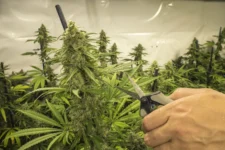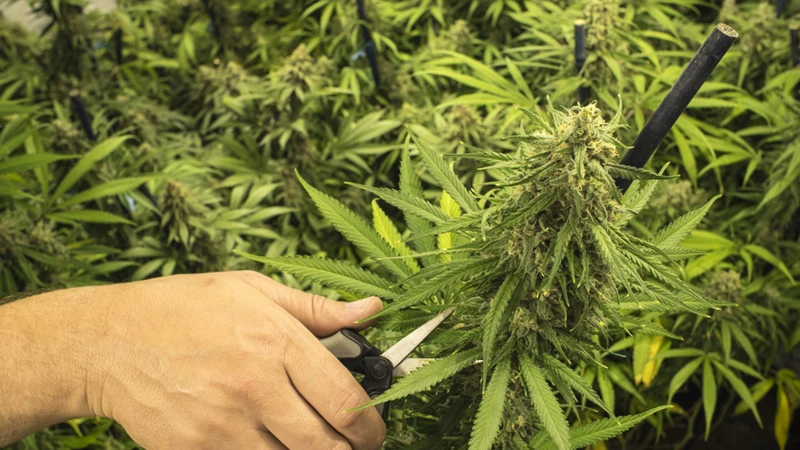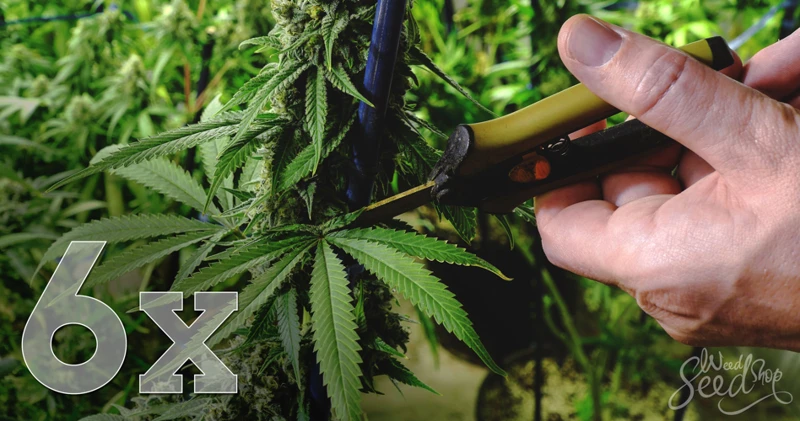
Maximizing Yield Through Trimming Techniques
Growing cannabis can be a rewarding and fulfilling experience, but maximizing the yield of your harvest requires careful attention to detail at every stage of the process. One critical step in achieving a bountiful harvest is trimming your cannabis plants effectively. However, for many growers, the process of trimming can be intimidating, leaving them unsure of when to trim, what tools to use, and how to achieve the best results for their yield. In this article, we will explore the ins and outs of effective trimming techniques, offering practical tips and guidance to help you achieve maximum yield from your cannabis plants.
When to Trim Your Cannabis Plants
Contents
As a cannabis grower, one of the most important decisions you’ll make is when to trim your plants. Knowing the right time to trim can help you achieve the best possible yields and produce high-quality buds. However, it can be difficult to determine when to start trimming, especially if you’re new to growing. In this section, we’ll guide you through the different stages of plant growth and help you identify the optimal time for trimming your cannabis plants.
Early Vegetative Stage
During the early vegetative stage, your cannabis plants will start to develop their fan leaves, which are necessary for photosynthesis. However, not all of these leaves will be needed for the plant’s growth, and some may even detract from it.
Identify the leaves: Before you start trimming, you need to identify which leaves to remove. Look for leaves that are yellowing, damaged, or blocking the growth of other leaves. These leaves will not contribute to the plant’s overall health and should be removed.
Use pruning shears: To ensure a clean cut, use pruning shears rather than tearing the leaves off. This will also help prevent any damage to the remaining leaves.
Trim away: Be sure to only remove a few leaves at a time, giving the plant time to recover between trimmings. Start by removing the larger fan leaves, focusing on those that are shadowing the smaller leaves. You can also remove any leaves that are growing too close together or towards the bottom of the stem.
Monitor your plant: After you’ve completed your trimming, keep an eye on your plant to ensure it’s recovering well. You should see new growth within a few days, and the remaining leaves should be greener and more vibrant.
By following these early vegetative stage trimming techniques, you can help maximize the growth potential of your cannabis plants and ensure they’re on track for a healthy and high-yielding harvest.
Flowering Stage
During the flowering stage, your cannabis buds will start to form, and this is when trimming becomes especially important. You will want to remove any leaves that are blocking light from reaching the buds, as this can significantly impact your yield.
The best time to trim during the flowering stage is right before the plant enters its last two weeks of growth. At this point, the plant will be focused on bud development, so removing any unnecessary foliage will help the plant direct its energy towards producing bigger, more potent buds.
When trimming during the flowering stage, it’s important to be gentle and careful not to disturb the buds. To ensure that you’re trimming effectively, it may be helpful to use a magnifying glass or jeweler’s loupe to get a close look at the buds and identify any leaves that need to be removed.
| Tools you’ll need: | Techniques to use: |
|---|---|
| Small trimming scissors or shears | Fan leaf removal: Gently snip away any large fan leaves that are blocking light from reaching the buds, being careful not to damage the buds themselves. |
| Magnifying glass or jeweler’s loupe | Sugar leaf trimming: Use your scissors to carefully remove any excess leaves from the buds, being sure to leave enough to protect the trichomes. |
| Latex gloves | Clean up: Once you’ve finished trimming, use the gloves to collect and dispose of any trimmings and other plant material. |
By trimming effectively during the flowering stage, you can maximize your yield and produce high-quality buds that are free of excess foliage. Just be sure to keep a close eye on your plants and be gentle as you trim to avoid damaging the buds or stalling their growth.
How to Trim Your Cannabis Plants
Trimming cannabis plants can be a daunting task for any grower, but it is a necessary step in optimizing the yield and potency of your crop. Whether you are a beginner or an experienced cultivator, using the right tools and techniques is essential to ensure a successful outcome. In this section, we will explore the tools you need and the steps to follow when trimming your cannabis plants for maximum yield and quality. So let’s get started!
The Tools You Need
When it comes to trimming your cannabis plants, you will need the right tools to ensure a clean and efficient process. Here are the essential tools you will need:
- Sharp scissors or trimming shears: You’ll need sharp scissors or trimming shears to make precise, clean cuts. It is important to keep them clean and sharp to avoid damaging the cannabis plants.
- Protective gloves: Trimming can be tough on your hands, so it’s important to wear protective gloves while you work. Some people prefer latex gloves, while others prefer nitrile gloves to avoid any possible allergic reactions.
- Alcohol wipes or rubbing alcohol: You want to avoid contaminating your cannabis plants, which is why it’s important to use alcohol wipes or rubbing alcohol to clean your tools before and after use.
- A clean, flat surface: You will need a clean, flat surface to work on while trimming your cannabis plants. Some people prefer to use a large tray or table covered with paper towels to make clean up easier.
- Containers: You will need containers to hold the trimmed cannabis leaves and buds. Some people prefer to use plastic bags, while others prefer glass jars to avoid trapping moisture.
- A comfortable chair: Trimming can be a long and tedious process, so it’s important to have a comfortable chair and good lighting to avoid straining your eyes and back.
Having the right tools for trimming your cannabis plants will not only make the process easier, but it will also ensure that you get the cleanest and most efficient cuts, which will help to maximize your yield.
Techniques for Trimming Fan Leaves
When it comes to trimming fan leaves, there are a few techniques to keep in mind to ensure that you are maximizing your yield. Below are some of the most effective techniques:
| Technique | Description |
|---|---|
| Finger Pinching | This trimming technique involves manually pinching off the fan leaves with your fingers. It is a precise method that allows you to selectively remove leaves that are blocking the growth of new buds. |
| Scissors | Using a sharp pair of scissors, carefully cut away the fan leaves that are covering the buds. This method requires a bit more time and effort, but it is useful for removing larger leaves that are blocking multiple buds at once. |
| Razor Blade | Using a clean and sharp razor blade, carefully cut away the fan leaves from the base of the stem. This method requires a steady hand and a lot of precision, but it is ideal for removing leaves that are very close to the buds. |
It is important to note that when trimming fan leaves, you should always be careful not to remove too many leaves at once. Removing too many leaves can stress the plant and affect its overall growth and yield. Aim to remove only the leaves that are necessary to allow for better air flow and light penetration to the buds. Remember to always sanitize your tools between cuts to prevent the spread of any potential diseases or pests.
Techniques for Trimming Sugar Leaves
When it comes to trimming sugar leaves, there are a few techniques that can help maximize your yield. Sugar leaves are the small leaves that grow out of buds and are covered in trichomes. While they may not have as much potency as the buds themselves, they still contain valuable cannabinoids that can be extracted. Here are some effective techniques for trimming sugar leaves:
| Technique | Description |
|---|---|
| Hand trimming | This technique involves using scissors or pruning shears to carefully remove the sugar leaves from the buds. It allows for precision and control, but can be time-consuming. |
| Wet trimming | This technique involves trimming the sugar leaves immediately after harvesting the plant while the buds are still wet. It can make the trimming process easier and faster, but may also reduce potency and flavor. |
| Dry trimming | This technique involves trimming the sugar leaves after the buds have been dried and cured. It can enhance potency and flavor, but may also be more difficult and time-consuming than wet trimming. |
| Tumbler trimming | This technique involves using a trimming machine, also known as a tumbler, to remove the sugar leaves from the buds. It can be efficient and fast, but may also damage the buds and reduce overall quality. |
Ultimately, the best technique for trimming sugar leaves will depend on your personal preferences and the specific needs of your plant. However, by using these techniques effectively, you can maximize your yield and produce high-quality cannabis buds.
Maximizing Yield Through Trimming
Once your cannabis plants have reached maturity, it’s time to start thinking about trimming them. Proper trimming techniques can help you maximize your yield and improve the overall quality of your crop. However, not all trimming techniques are created equal. It’s important to know which tools and techniques to use to get the most out of your plants. In this section, we’ll dive into the importance of proper trimming and how it can impact your yield. We’ll also discuss specific techniques you can use to trim your plants effectively. Let’s get started.
The Importance of Proper Trimming
Proper trimming is crucial for maximizing yield and the overall quality of your cannabis plants. Trimming is essential because it helps to remove unwanted leaves and other plant material that can hinder growth and reduce yield.
Without proper trimming, your cannabis plants may become bushy and crowded, which can create a breeding ground for pests and diseases. By removing excess plant material, you can improve airflow and light penetration, allowing your plants to grow strong and healthy.
Not only does trimming improve the health of your plants, but it can also improve the potency and flavor of your final product. Trimming allows you to remove unwanted plant material, such as fan leaves and sugar leaves, which can contain lower amounts of beneficial cannabinoids and terpenes. This means you can concentrate the most desirable parts of the plant, such as the buds, for a more potent and flavorful harvest.
In addition to improving the quality of your cannabis, proper trimming can also improve your bottom line. By removing excess leaves and plant material, you can increase your yield by up to 20%. This means more products to sell and greater profits for your efforts.
Proper trimming is crucial for successful cannabis cultivation. It helps to improve plant health, potency, and yield, making it an essential step in the growing process.
How Trimming Affects Yield
Trimming is an essential aspect of cannabis cultivation that can significantly impact yield. When done correctly, trimming can increase bud density, optimize light penetration, and enhance airflow, all of which can result in higher yields. Here are some of the ways trimming affects yield:
- Bud density: Trimming can increase the density of buds by removing excess foliage that blocks light from reaching lower buds. This creates a more even canopy, promoting more bud growth and producing heavier buds.
- Light penetration: By removing unnecessary leaves, the remaining foliage can better absorb light, which enhances photosynthesis and leads to better flower development.
- Airflow: Proper trimming helps optimize airflow through the plant, reducing the chances of mold or mildew growth and improving overall plant health. Improved airflow also allows for better CO2 exchange and oxygenation.
- Elimination of nutrient-sapping: Dying, damaged or infected leaves on the plant can sap precious nutrients from the buds. Trimming these parts off ensures that the remaining energy can be used for bud production.
It’s important to note that while trimming can enhance yield, over-trimming can severely harm the plant’s growth and development. It’s essential to strike a balance between trimming enough to improve yield, but not too much that it affects the plant’s overall health.
Conclusion
In conclusion, effective trimming techniques are essential for maximizing yield and producing high-quality cannabis. By removing excess foliage and focusing growth on the buds, trims can significantly increase the potency and abundance of the final product.
It is important to understand when to trim, with early trimming best in the vegetative stage and more strategic trims during flowering. The right tools and techniques are necessary to perform successful trims, starting with the proper scissors or shears.
When it comes to trimming fan versus sugar leaves, different techniques are required. Fan leaves are best removed entirely, while sugar leaves should be selectively trimmed in order to preserve the important trichomes which contain cannabinoids.
Proper trimming is critical to maximizing yield, as the plant can concentrate more energy on producing THC and other desired compounds without having to feed its foliage. This can result in more potent, heavier buds that are more valuable on the market.
In conclusion, growers who want to produce the best possible cannabis should pay close attention to their trimming techniques. With careful attention to detail and a commitment to effective trims, the end result will be a high-quality product that will satisfy even the most discerning cannabis connoisseur.
Frequently Asked Questions
How often should I trim my cannabis plants during the flowering stage?
It depends on the strain, but most growers trim their plants every 1-2 weeks during the flowering stage.
What are the benefits of trimming my cannabis plants?
Trimming your cannabis plants can increase airflow, reduce the risk of mold and mildew, and improve the overall appearance of your plants.
Can I use regular scissors to trim my cannabis plants?
Yes, you can use regular scissors, but it’s recommended to use specialized trimming scissors or shears for a more precise cut.
What are sugar leaves?
Sugar leaves are the small leaves that grow around the buds of the cannabis plant. They get their name from the sticky resin that covers them, which contains the plant’s cannabinoids and terpenes.
Should I remove all of the fan leaves during the flowering stage?
No, you should leave some fan leaves on your plants during the flowering stage to help with photosynthesis and nutrient production.
What is the difference between wet and dry trimming?
Wet trimming involves cutting the leaves off of the plant immediately after harvesting, while dry trimming involves waiting until the plant has dried before removing the leaves. Dry trimming can result in a better taste and smoother smoke, but wet trimming is faster and easier.
How long does it take for a cannabis plant to recover after being trimmed?
It typically takes 3-5 days for a cannabis plant to recover after being trimmed.
What is the best time of day to trim cannabis plants?
It’s best to trim your cannabis plants during the early morning or late afternoon when the temperature and humidity are lower, and the sun isn’t as intense.
What is defoliation, and should I do it?
Defoliation is the process of removing a large number of leaves from a cannabis plant. It’s a controversial technique that some growers believe can increase yield, while others think it can stress the plant and reduce overall health.
What is a trim tray, and do I need one?
A trim tray is a specialized tray used for trimming cannabis plants to collect the excess leaves and trimmings. While you don’t necessarily need a trim tray, many growers find it to be a convenient tool that can make the trimming process easier and faster.




